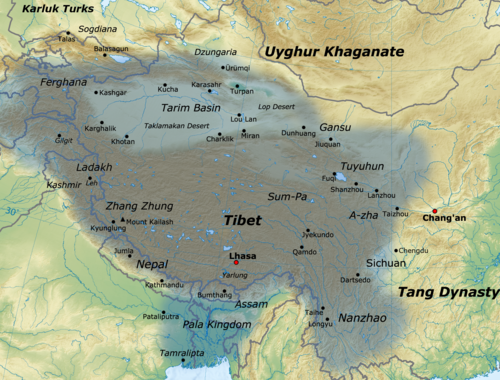Tubo
(Redirected from Tibetan empire)
Tubo (Chinese: 吐蕃;, Tibetan: བོད་ཆེན་པོ, bod chen po), also called the Tibetan Empire, existed from the 7th to 9th centuries. Its first king was Songtsen Gampo. Its second king was Mangsong Mangzan. It controlled the Tibetan Plateau as well as parts of Central Asia and South Asia. They came after the Zhangzhung people, who practiced the Bon religion. The Tibetan empire combined Buddhism with the native Bon religion, and created Tibetan Buddhism. Gampo also helped invent the Tibetan alphabet during this time.
Tubo (吐蕃、大蕃国) བོད་ཆེན་པོ། Bod chen po | |||||||||||||
|---|---|---|---|---|---|---|---|---|---|---|---|---|---|
| 618–842 | |||||||||||||
 Map of the Tibetan empire at its greatest extent between the 780s and the 790s | |||||||||||||
| Capital | Lhasa | ||||||||||||
| Common languages | Tibetan language | ||||||||||||
| Religion | Tibetan Buddhism, Bön | ||||||||||||
| Government | Monarchy | ||||||||||||
| Tsenpo (Emperor) | |||||||||||||
• 618–650 | Songtsen Gampo (first) | ||||||||||||
• 756–797 | Trisong Detsen | ||||||||||||
• 815–838 | Ralpacan | ||||||||||||
• 838–842 | Langdarma (last) | ||||||||||||
| Lönchen (Chief Minister) | |||||||||||||
• 652–667 | Gar Tongtsen Yülsung | ||||||||||||
• 685–699 | Gar Trinring Tsendro | ||||||||||||
• 782?–783 | Nganlam Takdra Lukhong | ||||||||||||
• 783–796 | Nanam Shang Gyaltsen Lhanang | ||||||||||||
| Banchenpo (Chief Monk) | |||||||||||||
• 798–? | Nyang Tingngezin Sangpo (first) | ||||||||||||
• ?–838 | Dranga Palkye Yongten (last) | ||||||||||||
| History | |||||||||||||
• | 618 | ||||||||||||
• | 842 | ||||||||||||
| Area | |||||||||||||
| 800 est.[1][2] | 4,600,000 km2 (1,800,000 sq mi) | ||||||||||||
| |||||||||||||
| Today part of | China India Nepal Pakistan | ||||||||||||
References
- ↑ Turchin, Peter; Adams, Jonathan M.; Hall, Thomas D (December 2006). "East-West Orientation of Historical Empires". Journal of World-systems Research. 12 (2): 222. ISSN 1076-156X. Retrieved 2016-09-14.
- ↑ Rein Taagepera (September 1997). "Expansion and Contraction Patterns of Large Polities: Context for Russia". International Studies Quarterly. 41 (3): 500. doi:10.1111/0020-8833.00053. JSTOR 2600793.
![[source?]](https://upload.wikimedia.org/wikipedia/commons/thumb/2/28/Tibetan_snow_leopard.svg/250px-Tibetan_snow_leopard.svg.png)